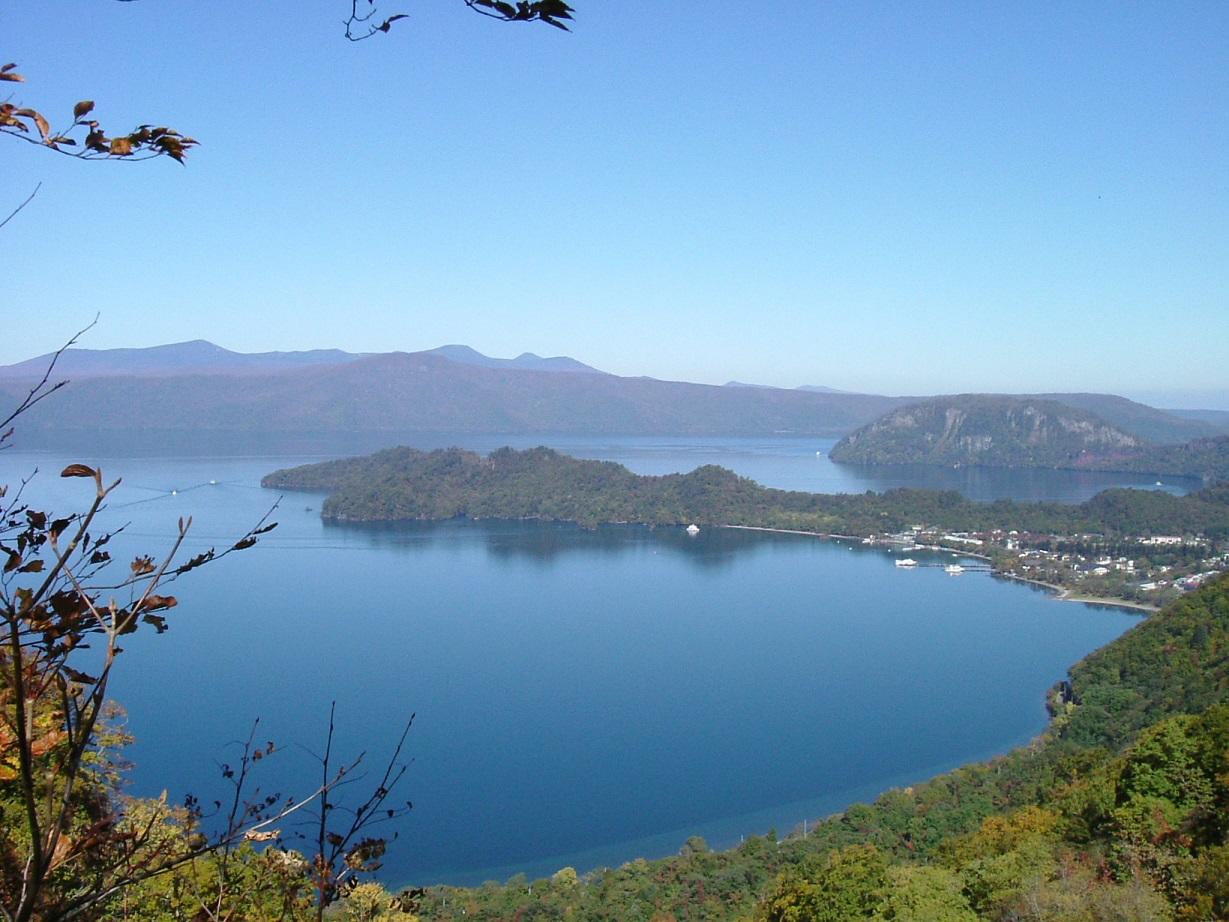Bulletin of the Geological Survey of Japan Top Page
Bulletin of the Geological Survey of Japan Vol.67 No.6 (2016)
Cover photograph | Table of Contents | Abstract
Cover photograph
A view of Lake Towada from Kougakudai lookout
Lake Towada, located on the border of Aomori and Akita prefectures, is a caldera lake formed by the volcanic activity of Towada volcano. The diameter of the caldera is approximately 11 km. There are three stages in the eruptive history of Towada volcano: the pre-caldera (200-55 ka), caldera-forming (55-15 ka), and post-caldera (15-0 ka) stages. The lake was formed by eruptions during the caldera-forming stage. In the post-caldera stage, a small stratovolcano was formed in the center of the caldera, followed by the subsequent formation of a small caldera of 2 km diameter on the top. The calderas, both filled with water, have formed double caldera topography.
(Photograph and Caption by Takashi Kudo)
Table of Contents
All the pages PDF : 67_05_full.pdf [22MB]
| Title | Author | |
|---|---|---|
| Article | ||
| Characteristics of changes in groundwater level and groundwater temperature based on long-term monitoring in the Aizu Basin, Fukushima, Japan |
Shohei Kaneko, Naoaki Shibasaki, Miyu Shoji and Youhei Uchida(p183-208)
|
67_06_01.pdf[8.1MB] |
| Report | ||
| K–Ar ages of lavas from the pre-caldera stage, Towada volcano, Northeast Japan |
Takashi Kudo (p209-215)
|
67_06_02.pdf [2.7MB] |
Abstract
Characteristics of changes in groundwater level and groundwater temperature based on long-term monitoring in the Aizu Basin, Fukushima, Japan
Shohei Kaneko, Naoaki Shibasaki, Miyu Shoji and Youhei Uchida
Groundwater level and groundwater temperature have continuously been monitored at 16 sites in the Aizu Basin, Fukushima Prefecture. Groundwater level, which declined by pumpage for snow-melting in winter around the urban areas, gets recovered in summer. However, it cannot necessarily reach to its level of previous years. In these sites, water balance may be deficit. Groundwater temperature in some deep wells declined year by year. This is because groundwater in shallow aquifer is drawn downward by decline of groundwater level in deep wells in winter. In this region, groundwater temperature is considered to be affected by not only thermal conductivity but also the induced groundwater flow by artificial pumpage.
K–Ar ages of lavas from the pre-caldera stage, Towada volcano, Northeast Japan
Takashi Kudo
Towada volcano is an active volcano located in the northern part of the Northeast Japan arc. K–Ar ages of lavas exposed at the Towada caldera wall were determined to establish a detailed eruptive history during the pre-caldera stage of Towada volcano. The obtained K–Ar ages were 0.26 ± 0.07 and 0.13 ± 0.06 Ma for Ohanabeyama Lava and 0.09 ± 0.06 and 0.09 ± 0.06 Ma for Hakka Lava and Pyroclastics. Although these K–Ar ages have large error ranges, they are consistent with stratigraphy. Distal tephra stratigraphy at the Kamikita Plain suggests that the main volcanic activity of Towada volcano have started at no earlier than ca.0.22 Ma. The newly obtained K–Ar ages of proximal lavas are consistent with the onset age of the volcanic activity estimated from the distal tephra stratigraphy.
Geological Survey of Japan, AIST
- About GSJ
- Our Activities
- Purchase guide
-
Publications and Database
- information
- Bulletin of the Geological Survey of Japan
- bull2025(Vol.76)
- bull2024(Vol.75)
- bull2023(Vol.74)
- bull2022(Vol.73)
- bull2021(Vol.72)
- bull2020(Vol.71)
- bull2019(Vol.70)
- bull2018(Vol.69)
- bull2017(Vol.68)
- bull2016(Vol.67)
- bull2015(Vol.66)
- bull2014(Vol.65)
- bull2013(Vol.64)
- bull2012(Vol.63)
- bull2011(Vol.62)
- bull2010(Vol.61)
- bull2009(Vol.60)
- bull2008(Vol.59)
- bull2007(Vol.58)
- bull2006(Vol.57)
- bull2005(Vol.56)
- bull2004(Vol.55)
- bull2003(Vol.54)
- bull2002(Vol.53)
- bull2001(Vol.52)
- Bulletin of the Geological Survey of Japan(old)
- Annual Report on Active Fault and Paleoearthquake Researches
- Reports, Geological Survey of Japan
- CCOP-GSJ Groundwater Project Report
- CCOP Technical Bulletin
- Cruise Report
- Geological Hazards
- Learning and Education
- GSJ Database Collection
- Collection of links


